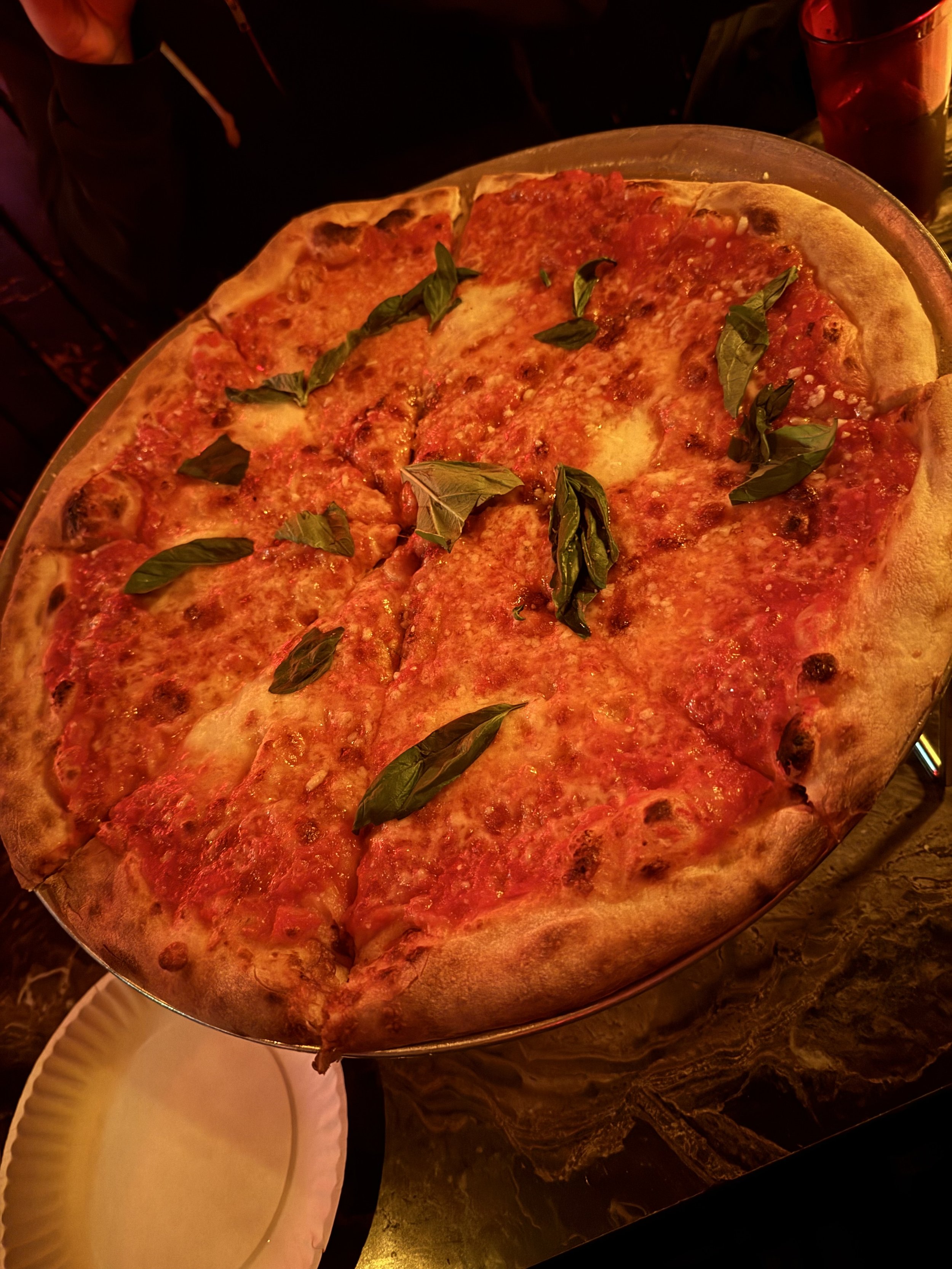Dino’s large cheese pizza; Sheila Heti’s short story; and a young YIMBY’s succinct pro-housing testimony.
I’m All Lost In
#68
The 3 things I’m obsessing about THIS week
1) The 18” Round Cheese Pizza at Dino’s
Setting aside veganism for a large cheese pizza with my pal Valium Tom has been a birthday tradition (on both our bdays) ever since I otherwise went vegan in 2018. Nowadays, I’ve extended this cheesy transgression to basically whenever we get together. While I rarely eat cheese, I’m no longer a Maoist when it comes to being vegan, and for my latest, overdue pizza hang out with Tom—which we’d scheduled for Saturday night—we lackadaisically decided on Big Mario’s.
Big Mario’s, I guess.
Though Big Mario’s hardly constitutes pizza nirvana, their slack, greasy slices do fit the bill for our semi-regular pizza get-togethers. For the record, in our bygone (and my pre-vegan) days, we’d hit the long-since-vanished Piecora’s where their slack crust was somehow also crisp and pillowy, making for the best pizza pies in town.
Last time at Seattle’s Piecora’s, April, 2014
Fortuitously, on Friday night, after I got a mushroom paste gyro at Yalla with XDX, she decided to get her post-whisky fix at the pizza spot next door, Dino’s, a red neon landmark I’d been aware of, but had never tried.
Upon entering Dino’s, a retro grunge place with a friendly sit-wherever-you- like-guys staff, I couldn’t help notice the full-moon-sized cheese pizzas basking in their oven racks. I promptly texted Tom to recommend a change in our pending plans. He texted right back with an exclamation mark noting that his Gen Z son was “a fan of that place.”
With smokier cheese and spicier red sauce than Big Mario’s slices, and—akin to Piecora’s—having a spongy density with a pinch of magical yeast, Dino’s pies mean Valium Tom and I no longer have to settle for pizza that merely fits the bill. Dino’s 18” classic—rich marinara sauce, plush mozzarella, fresh basil, and a fluffy oven-singed crust—tops the bill.
1/25/25
Evidently, I’m not the only one who’s keen on Dino’s. After telling my pal Glenn about Saturday night’s tasty outing, he reported that his crew did a pizza bracket a few years back and Dino’s, which also serves square, semi-deep-dish slices, carried the day in their citywide pizza pie taste test.
2) Sheila Heti’s Short Story in the 1/27/25 the New Yorker
Contemporary writer Sheila Heti has shown up on this obsessions list before; in February 2024, I was taken with her poetic and racy diary, which she creatively reshuffled—alphabetically, by the first word of every sentence.
This week, stuck for something to read before bed (the 800-page Hanya Yanagihara novel I started earlier this month just isn’t taking), I was happy to see Heti’s byline on the latest New Yorker fiction piece.
I don’t know if there’s a term for this genre of fiction where creepy and slightly off-kilter, near-future settings are draped over understated short stories. (Argentinian writer Samanta Schweblin’s 2009 collection, Mouthful of Birds, translated in 2019, turned me on to this unsettling blend of casual and magical.
Heti’s The St. Alwynn Girls at Sea is seemingly set at an early-20th Century private girls school in an enigmatic late-21st century world war all at once. Even more disorienting, the students talk in the contemporary 2025 therapy speak of precocious tween girls who likely go on five-star vacations with their progressive moms.
The school is housed on a boat that’s sailing the world to avoid the war and it’s here we meet blunt and cynical Lorraine, extroverted and performatively mystical Dani, and naive and depressed Flora who play out a mild Lord of the Flies drama involving a dorm room oracle (a photo of a former-classmate-turned-child-star). This Delphic soothsayer dispenses divination about Dani’s epistolary crush on a boy named Sebastien.
There are several meaningful surprises as Heti’s teeny bopper myth moves toward its ennui-ridden conclusion, including Sebastien’s vulnerable eloquence, Flora’s class conscious denouement (daydreaming as she’s mopping the deck), and Lorraine’s alarmed apology.
The odd tonal and historical dualities in Heti’s story (which also reads like a quiet spoof of the witchy overtones you’d find in some Shirley Jackson short story about quasi supernatural girls at a boarding school) achieve comedic yet literary elegance as Dani—with the philosophical inner turmoil of a Queen’s English Jane Austen protagonist—ruminates over the idea of a hand job.
3) A YIMBY’s Succinct Testimony
After a parade of typical (and banal) testimony—”I support more housing, but…”— at this week’s city council hearing on the Comprehensive Plan’s slight upzone for more density in Seattle’s traditional single-family zones (“but developers…” “but neighborhood character…” “but renters…”), a young Asian guy who only gave his name as Rata challenged the selfish privilege of Seattle single-family housing preservationists.
Hello, my name is Rata. There’s a lot of fear going on. Seattle’s growing. And with growth comes a lot of that fear. We need to house 200,000 people in the next what 10 years. … We’re gonna put all that in a place that already has density? You need to do the brave thing. Open up more land on single family housing, so we can put more multi-generational, more multi-family housing on there. That’s the only way to do this. That’s the only way we’re going to meet our needs. …
His concise testimony, at the 17:46 minute mark here, was music to my pro-apartment ears.
His conclusion was perhaps the most powerful part, though.
As we see the climate crisis will bring more climate refugees to the Pacific Northwest. And we need to meet that need.
While this certainly strays into conjecture rather than tangible data, Rata’s dystopian visions of (likely) environmental catastrophe work regardless of their speculative nature. Much as the best science fiction calls attention to the implications of contemporary missteps, Rata gave the pro-housing position the weight it demands, especially over transitory issues like “neighborhood character.” By alerting people to the environmental hazards of our low-density status quo (where the housing equity, transit feasibility, and resource efficiency that’s needed to avert climate disaster isn’t possible) his dramatic touch put upzoning in its appropriately urgent context.
————
And lastly, this week’s recommended listening: Put on this chill playlist, “Healing Harp,” at bedtime.





